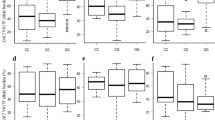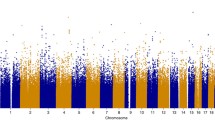Abstract
Polycythemia vera, essential thrombocythemia, and primary myelofibrosis are myeloproliferative neoplasms, characterized in a majority of cases by a unique somatic point mutation, JAK2 V617F. Recently, it was shown that JAK2 V617F occurs more frequently on a specific JAK2 haplotype, named JAK2 46/1. We genotyped 149 myeloproliferative neoplasms patients (69 had polycythemia vera, 65 had essential thrombocythemia, and 15 had primary myelofibrosis) with a known JAK2 V617F mutational status and 150 controls for the JAK2 rs10974944 (C/G) single nucleotide polymorphism, in which the G allele tags the 46/1 haplotype. We found that the rs10974944 GG/CG genotypes were significantly enriched in patients compared to controls (p < 0.0001). After stratifying for the JAK2 V617F mutational status and for the mutant allele burden, we demonstrated that GG/CG genotypes were significantly more frequent in V617F positive compared to V617F negative patients (p = 0.001), but not in V617F negative patients compared to controls (p = 0.29). Similarly, the GG/CG genotypes were significantly enriched in V617F positive patients with a mutant allele burden >50% compared to those with a mutant allele burden <50% (p = 0.0006). Our results indicate that the G allele, part of the JAK2 46/1 haplotype, contributes significantly to the occurrence of JAK2 V617F-positive myeloproliferative neoplasms. Moreover, JAK2 46/1 seems to be associated with mutant allele burden >50% in JAK2 V617F-positive myeloproliferative neoplasms patients.
Similar content being viewed by others
References
Jones AV, Kreil S, Zoi K, Waghorn K, Curtis C, Zhang L et al (2005) Widespread occurrence of the JAK2 V617F mutation in chronic myeloproliferative disorders. Blood 106:2162–2168
Dameshek W (1951) Some speculations on the myeloproliferative syndromes. Blood 6:372–375
Kralovics R, Passamonti F, Buser AS, Teo SS, Tiedt R, Passweg JR et al (2005) A gain-of-function mutation of JAK2 in myeloproliferative disorders. N Engl J Med 352:1779–1790
James C, Ugo V, Le Couedic JP, Staerk J, Delhommeau F, Lacout C et al (2005) A unique clonal JAK2 mutation leading to constitutive signaling causes polycythaemia vera. Nature 434:1144–1148
Baxter EJ, Scott LM, Campbell PJ, East C, Fourouclas N, Swanton S et al (2005) Acquired mutations of the tyrosine kinase JAK2 in human myeloproliferative disorders. Lancet 365:1054–1061
Levine RL, Wadleigh M, Cools J, Ebert BL, Wernig G, Huntly BJ et al (2005) Activating mutation in the tyrosine kinase JAK2 in polycythemia vera, essential thrombocythemia, and myeloid metaplasia with myelofibrosis. Cancer Cell 7:387–397
Tefferi A, Vardiman JW (2008) Classification and diagnosis of myeloproliferative neoplasms: the 2008 World Health Organization criteria and point-of-care diagnostic algorithms. Leukemia 22:14–22
Kralovics R, Teo SS, Li S, Theocharides A, Buser AS, Tichelli A et al (2006) Acquisition of the V617F mutation of JAK2 is a late genetic event in a subset of patients with myeloproliferative disorders. Blood 108:1377–1380
Pardanani A, Fridley BL, Lasho TL, Gilliland DG, Tefferi A (2008) Host genetic variation contributes to phenotypic diversity in myeloproliferative disorders. Blood 111:2785–2789
Delhommeau F, Dupont S, Della Valle V, James C, Trannoy S, Masse A et al (2009) Mutation in TET2 in myeloid cancers. N Engl J Med 360:2289–2301
Tefferi A, Pardanani A, Lim KH, Abdel-Wahab O, Lasho TL, Patel J et al (2009) TET2 mutations and their clinical correlates in polycythemia vera, essential thrombocythemia and myelofibrosis. Leukemia 23:905–911
Carbuccia N, Murati A, Trouplin V, Brecqueville M, Adelaide J, Rey J et al (2009) Mutations of ASXL1 gene in myeloproliferative neoplasms. Leukemia 23:2183–2186
Lasho TL, Pardanani A, McClure RF, Mesa RA, Levine RL, Gilliland DG et al (2006) Concurrent MPL515 and JAK2V617F mutations in myelofibrosis: chronology of clonal emergence and changes in mutant allele burden over time. Br J Haematol 135:683–687
Jones AV, Chase A, Silver RT, Oscier D, Zoi K, Wang YL et al (2009) JAK2 haplotype is a major risk factor for the development of myeloproliferative neoplasms. Nat Genet 41(4):446–449
Olcaydu D, Harutyunyan A, Jäger R, Berg T, Gisslinger B, Pabinger I et al (2009) A common JAK2 haplotype confers susceptibility to myeloproliferative neoplasms. Nat Genet 41(4):450–454
Kilpivaara O, Mukherjee S, Schram AM, Wadleigh M, Mullally A, Ebert BL et al (2009) A germline JAK2 SNP is associated with predisposition to the development of JAK2V617F-positive myeloproliferative neoplasms. Nat Genet 41(4):455–459
Pardanani A, Lasho TL, Finke CM, Gangat N, Wolanskyj AP, Hanson CA et al (2010) The JAK2 46/1 confers susceptibility to essential thrombocythemia regardless of JAK2V617F mutational status—clinical corelates in a study of 226 consecutive patients. Leukemia 24(1):110–114
Tefferi A, Lasho TL, Patnaik MM, Finke CM, Hussein K, Hogan WJ et al (2010) JAK2 germline genetic variation affects disease susceptibility in primary myelofibrosis regardless of V617F mutational status: nullizygosity for the JAK2 46/1 haplotype is associated with inferior survival. Leukemia 24(1):105–119
Trifa AP, Cucuianu A, Popp RA (2010) Development of a reliable PCR-RFLP assay for investigation of the JAK2 rs10974944 SNP, which might predispose to the acquisition of somatic mutation JAK2 V617F. Acta Haematol 123(2):84–87
Olcaydu D, Skoda RC, Looser R, Li S, Cazzola M, Pietra D et al (2009) The ‘GGCC’ haplotype of JAK2 confers susceptibility to JAK2 exon 12 mutation-positive polycythemia vera. Leukemia 23:1924–1926
Acknowledgment
The authors would like to thank to Dr. Adriana Stan, Genetic Lab, Bucharest, Romania, for her help with the sequencing experiments.
Authorship and conflict of interest disclosure
APT designed research, performed genetic analysis, analyzed data, and wrote the manuscript. AC designed research, collected the samples and patients data, analyzed data, and wrote the manuscript. LP, LU, and DD collected the samples and patients data. MSM and IVP performed genetic analysis. RAP designed research and analyzed data.
The authors reported no potential conflict of interest.
Author information
Authors and Affiliations
Corresponding author
Rights and permissions
About this article
Cite this article
Trifa, A.P., Cucuianu, A., Petrov, L. et al. The G allele of the JAK2 rs10974944 SNP, part of JAK2 46/1 haplotype, is strongly associated with JAK2 V617F-positive myeloproliferative neoplasms. Ann Hematol 89, 979–983 (2010). https://doi.org/10.1007/s00277-010-0960-y
Received:
Accepted:
Published:
Issue Date:
DOI: https://doi.org/10.1007/s00277-010-0960-y




